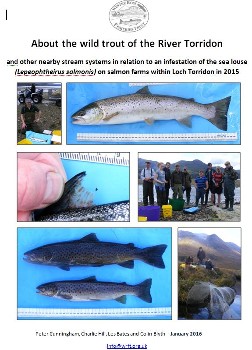On-farm sea louse infestation in Loch Torridon has mixed consequences for wild sea trout
Posted: Tuesday 5 January, 2016 @ 11:28:21

A report on the wild trout of the River Torridon and nearby waters in 2015 can be found on the downloads page of this website. The report presents the results of investigations to gather information about sea trout around the Loch Torridon area in 2015 following reports of exceptionally high concentrations of parasitic sea lice (Lepeophtheirus salmonis) on salmon farms within the area during the first six months of 2015.
Sea trout were sampled by Wester Ross Fisheries Trust during the period May – July 2015 using sweep netting, rod and line and electro-fishing. In October and early November 2015 a fyke net trap was operated in a tributary of the River Torridon to learn more about the spawning population of trout within that river system.
Sea trout carrying high or very high sea lice burdens (100 lice to 400+ lice per fish) were sampled from the River Balgy sea pool, Inverbain river estuary, Sand (by Gairloch) river estuary and Flowerdale River estuary. The most heavily infested fish were between 250mm and 350mm in length and were caught between late May and early July 2015. The majority of lice on heavily infested fish were ‘chalimus’ (juvenile) stage lice.
The occurrence of heavily lice-infested sea trout can most easily be explained by proximity to a very large adult female sea louse population on the salmon farms in the Loch Torridon area during the period January to June 2015 as can be inferred from reports on the SSPO Fish Health and Scottish Government’s ‘Scotland’s Aquaculture’ websites.
Levels of lice infestation on sea trout in some samples were in excess of potentially lethal thresholds discussed in published literature. The marine survival rate, especially of smaller trout in systems such as the River Balgy, may have been reduced by 50% or more as a result of sea lice infestation.
However, many mature sea trout were caught in the Torridon River fyke net trap in October and November 2015. These fish had survived and grown despite close proximity to sources of larval sea lice (i.e. nearby salmon farms). Some of these fish were older and larger than any of the sea trout sampled during the period 2007 – 2015 in the River Shieldaig system by Marine Scotland Science.
It is suggested that the overall impact of the Loch Torridon sea lice infestation in 2015 on sea trout populations around and beyond Loch Torridon varied according to geographic factors. The extensive intertidal area and west facing characteristics of the Torridon River estuary may provide River Torridon sea trout with better prospects of survival than sea trout entering the sea from other nearby stream systems (e.g. sea trout from the Shieldaig River).
In conclusion, this study suggests that the consequences of a severe sea lice infestation (associated with salmon farming) on wild trout populations varies according to whether or not sea trout from respective river systems have opportunities for finding fresh or brackish water areas where they can evade or rid themselves of parasitic sea lice, find food, and evade capture by seals and other potential predators of lice-infested fish.
Therefore, the threat from sea lice infestations associated with salmon farming to the productivity of respective sea trout fisheries will also vary according to geographic factors associated with the areas into which respective rivers discharge.
Peter Cunningham, January 2016 info@wrft.org.uk